
Dec 1, 2023 | Blog, Warehouse Operations
Managing a warehouse is about more than picking, packing, and shipping. Special projects set you apart from your competition, pad your bottom line, and help your organization to operate more efficiently and achieve its goals.
This article will discuss the role, types, mechanics, benefits, challenges, and considerations involved in special projects.
Understanding Special Projects
A special project is any request outside the normal pick-pack, receiving, or shipping processes. These requests could range from designing a custom packaging solution for a new product line to relabeling a batch of products.
In any warehouse operation, special projects can play a crucial role in helping a business adapt and innovate in response to new challenges or opportunities. By taking advantage of special projects, companies can stay ahead of the curve, improve their processes, and maintain a competitive edge.
Types of Special Projects
- Kitting: Packing multiple products under one SKU is known as kitting. Kitting combines two or more related items into one neat package or bundle. Instead of forcing customers to browse numerous options, kitted bundles make getting what they want effortless.
- FBA or Walmart Prep: Some 3PLs offer Walmart and FBA prep services for inbound receiving rules, including ASIN labeling, order packaging, and fulfillment center shipping.
- Wholesale/Retail Order Prep: 3PLs can provide transportation, order fulfillment, and inventory management services such as warehousing, distribution, shipping, handling, and tracking.
- Inventory Removal or Disposal Request: When a client wants items stored in a fulfillment center, returned, recycled, or thrown away.
- Barcoding Products: Barcode printing is time-consuming, but special projects can optimize the process by considering space, accuracy, and speed.
Process Optimization in Warehousing
The demand for companies to produce more with less has never been more pressing. Process optimization in a warehouse minimizes room for error, resulting in increased productivity and decreased operational expenses.
Using technology integration, companies can leverage predictive analytics to better forecast seasonal trends in demand and allocate resources accordingly.
The Mechanics of Special Projects
Every stage of setting up for special projects demands attention to detail, from project planning to monitoring and evaluation. With the right mechanics, special projects in the warehouse can be executed confidently and efficiently.
Project Planning
Work orders are critical for project planning in ShipHero facilities, providing a solid foundation for successful execution. With the ability to attach vital project details like images, videos, and documents, this feature ensures that every aspect of the project is accounted for, minimizing the chance of errors. You can easily track inventory movements in real-time, update progress, and assign tasks.
Watch our video walkthrough right here to learn more about work orders.
Execution
Collaboration between people with unique expertise is key to the success of these projects. Investing in employee training and development is also crucial, as it ensures your team has the knowledge and skills needed to tackle any project.
Implementing new technologies like WorkforceHero can connect employees with special projects, track data and locations in real-time, and follow your team’s progress. WorkforceHero informs decisions more comprehensively, reduces idle time by allowing you to pre-assign tasks ahead of your team’s arrival, and alerts potential improvements.
With the ability to track person-hours dedicated to each job or project, you’ll never forget to bill a client again.
Monitoring and Evaluation
Monitoring and evaluating metrics is important to ensure a warehouse operates smoothly and enables prompt and effective action to prevent supply chain failure.
It’s also essential to have a sophisticated system that can analyze and interpret large amounts of data, such as ShipHero WMS and our WorkforceHero. By continually striving for improvement and being adaptable to changing circumstances, your warehouse can thrive and maintain its effectiveness over the long term.
Watch our video walkthrough right here to learn more about WorkforceHero.
Benefits of Special Projects in a Warehouse
Prepping for special projects in a warehouse can offer several benefits to enhance overall efficiency, productivity, and operations.
- Process Improvement: Analyze and improve workflows to increase efficiency and reduce costs.
- Capacity Expansion: Improve warehouse capacity for special projects by optimizing storage space, implementing new shelving systems, or reorganizing inventory.
- Technology Integration: Use automation, robotics, or WMS to streamline operations and reduce errors.
- Inventory Accuracy: Update tracking and management systems to improve inventory accuracy, reduce stocking problems, and lower costs.
- Cost Reduction: Optimize processes to reduce labor and storage costs.
- Customer Satisfaction: Better warehouse operations resulting from special projects can improve order accuracy, faster order fulfillment, and shorter delivery times, enhancing customer satisfaction.
- Flexibility and Scalability: Special projects can make the warehouse more adaptable to changing business needs and market demands.
- Resource Allocation: Special projects help identify resource needs and allocate them more effectively, whether labor, equipment, or technology investments.
- Competitive Advantage: Special projects can give a competitive advantage by improving warehouse operations for faster response times, lower costs, and better service.
- Employee Development: Special projects improve employee skills and cross-train them, which can increase job satisfaction.
By implementing special projects in a warehouse, businesses can reap many benefits that improve operations, reduce costs, and enhance their competitiveness.
Challenges and Considerations
Special projects in warehouse operations are a unique challenge that requires effective project management.
The primary challenge is time. Effective time management through proper planning, scheduling, and monitoring to meet the deadline is essential.
Then, the project scope must be well-defined, with specific goals and deliverables outlined to ensure focus and desired outcomes.
Finally, it is essential to keep in mind the significant cost constraint. The project expenses include several factors, including monetary fees, labor, vendors, and quality control.
Workforce Training
A specific aspect to consider is the potential for workforce training and development. Warehouse workers can easily take on new challenges by providing specialized training.
The commitment and expertise of a well-trained warehouse team make them a valuable asset, enabling your business to stay ahead of the competition and be prepared for any unforeseen challenges.
Integration with Existing Systems
Warehouse operations can be complex and challenging, from managing space and inventory to mitigating risk and preparing for unexpected fluctuations in demand. Tackling these challenges is easy with the help of a warehouse management system (WMS).
As a smart nerve center for your warehouse, a WMS can provide powerful insights and optimizations that streamline your operations, protect your inventory, and drive profits.
Integration with existing systems is key, and ShipHero offers powerful integrations that ensure every part of your warehouse is covered, giving you visibility into all corners of your operation.
With ShipHero on your side, you can overcome any challenge and take your warehouse operations to new heights.
Harness the Power of Special Projects
Special projects can have a significant impact on your warehouse operations. Optimize your processes, collaborate with your team, and train your workforce to ensure their success.
While special projects can improve efficiency, enhance customer satisfaction, and increase competitiveness, they can be challenging to implement without proper workforce training and WMS integration. Evaluate your current approach and invest in advanced WMS integration for long-term success.

Key Takeaways
- Special projects are requests outside the normal pick-pack, receiving and shipping processes.
- Special projects include kitting, FBA or Walmart prep, wholesale/retail order prep, inventory removal or disposal requests, and barcoding products.
- Process optimization minimizes room for error and increases productivity with new technology integration.
- The mechanics of a special project involve project planning with work orders, execution with team collaboration and training, and monitoring/evaluating to assess outcomes.
- Benefits include process improvement, capacity expansion, technology integration, cost reduction, customer satisfaction, flexibility/scalability, resource allocation, competitive advantage, and employee development.
- Challenges and considerations involve expectations management, clearly defining the project scope, and highlighting cost constraint awareness.
- Workforce training and WMS integration are key to successful execution.
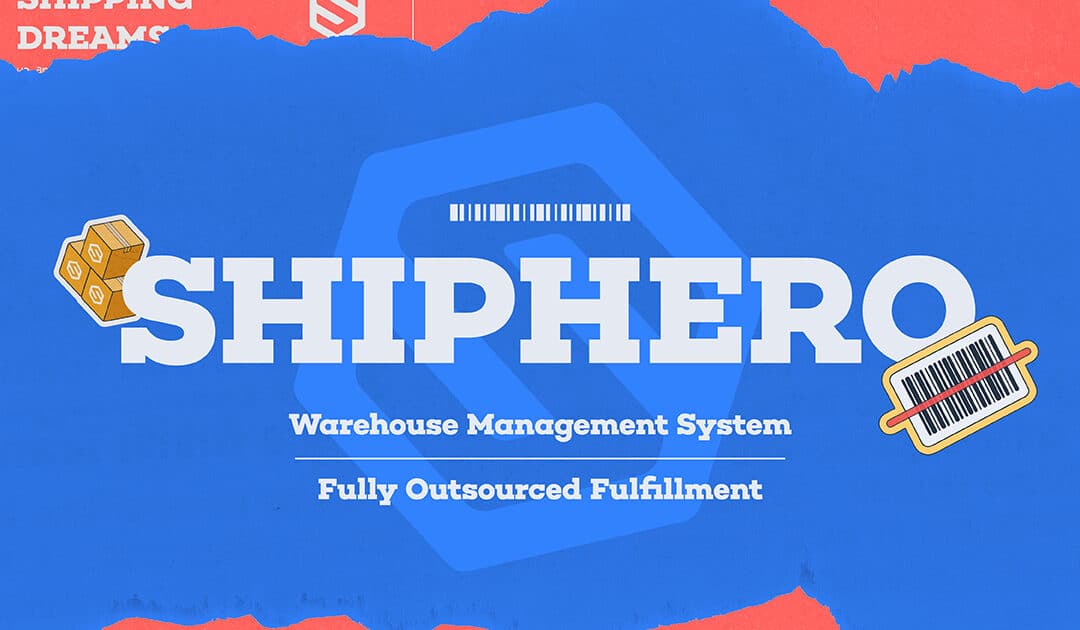
Oct 21, 2022 | Blog
Between priority shipping demands and expected free returns offers, it’s no secret that clients today want more from the businesses they shop. In light of these requirements, the technology used in warehouses is more important than ever. Luckily, smart warehousing means that companies have options when it comes to staying competitive. From inventory counting drones to the use of AI in logistics, smart warehouse technologies offer a number of benefits, including improved productivity, greater accuracy, and fewer accidents on the job.
The Importance of Smart Warehousing
Among the many benefits of smart warehousing technologies is the opportunity to protect your workforce from harm. By optimizing warehouse processes and utilizing AI where possible, companies can keep mistakes to a minimum while cutting down on accidents and injuries. In fact, studies show that utilizing warehouse robots could reduce both lifting injuries and those resulting from physical fatigue.
Just as smart tech protects workers, it can also lower your operating costs. By leveraging automation, businesses can empower their human labor team to focus on more specialized and technical tasks while also cutting picking errors. With current rates standing between 1 and 3 percent, companies that don’t go smart risk draining profitability by a whopping 13 percent overall.
Get to Know These Smart Warehousing Technologies
The good news is that the technology used in warehouses can go a long way toward helping your business better serve its clients while benefiting your bottom line. By simplifying the picking and packing process, you can empower your team to do more in less time while cutting costs company wide. Here are some of the ways automation and AI in logistics and supply chains are helping companies like yours achieve their goals.
Warehouse Management Systems
Smart warehousing technologies can give you access to critical warehouse data at the click of a button. An end-to-end warehouse management system like the one available through ShipHero offers expedited reporting, real-time statistics, and superior planning abilities. As a bonus, companies can streamline and automate many warehouse functions, allowing them to distribute labor where it can do the most good. The end result is both improved warehouse flexibility and better relationships with employees, suppliers and clients.
Autonomous Vehicles in Logistics
Incorporating automation and AI in logistics can have a big benefit on your bottom line. Also known as AGVs, automatic guided vehicles allow for the efficient storage of heavy materials while helping companies automate the receiving process. According to a report by PwC, the digitization and automation of these processes have the potential to reduce logistics costs nearly 50 percent by 2030. As a bonus, utilizing more autonomous guided vehicles can help protect your workers from injuries on the job, including muscle strains, falls, slips and repetitive motion injuries.
Drones in Warehouse Management
Inventory counting drones are another way for businesses to use technology to their advantage. Not only can drones easily scan barcodes and RFID tags, but they can also alert warehouse workers about the number of units in stock at any given time. The end result is that inventory disparities are found faster and with less effort from staff. Additionally, drones can help boost safety and minimize the number of dangerous tasks performed by workers.
Work Smarter, Not Harder
There’s a reason that new technologies often make a big splash when they are first introduced. The amount of work they can do, and the amount of stress they can take off the labor force is astonishing.
Smart warehousing technologies can have a profound impact on your bottom line. By incorporating AI and warehouse drones into your current management, you can save on costs while doing your part to protect the people who have helped make your business the success it is today.
If you want to find out more about ShipHero’s smart Warehouse Management Software, we invite you to talk to one of our sales team members today.

Maggie M. Barnett, Esq., is the COO of ShipHero
ShipHero
About the author: Maggie M. Barnett, Esq., is the COO of ShipHero. She is responsible for planning and executing the overall operational, legal, managerial and administrative procedures, reporting structures and operational controls of the organization. Barnett’s greatest strengths are leadership, risk mitigation, change management and a passion for business transformation. She is known for her expertise in delivering operational excellence and an ability to provide guidance and mitigating risk. Her leadership of ShipHero is grounded in a servant mentality, always doing the right thing for our stakeholders. Her passion for ShipHero comes from the ability to drive operational excellence throughout the organization impacting the lives of our employees, customers, and partners.
Follow Maggie on Twitter & LinkedIn.

Aug 19, 2022 | Blog
As labor shortages and warehouse delays continue to cause headaches across the supply chain, more fulfillment centers are seeking out ways to streamline the shipping process.
One innovative solution has been an investment in warehouse robotics. While this technology can work to reduce the risk of human error, they’re also expensive. Most fulfillment centers wont have the luxury of adopting large, high-end robots to handle their picking and packing.
The thing that makes warehouse robotics so valuable is their capacity for automation. Workers can easily customize these machines to fit their specifications and have confidence they’re tasks will be executed without the need for more input. Luckily, there are cheaper automation tools available that make shipping easier, without the overhead that comes with robots.
Let’s take a look at warehouse automation beyond robotics, and see what affordable options there are to modernizing a fulfillment center.
What is Warehouse Automation
When people think about automation in the warehouse, they might think of a fleet of robots and self-driving forklifts picking items and carrying them across the fulfillment center. However, with today’s technology, warehouse automation can be achieved on a much smaller, and more affordable scale.
Warehouse automation is actually defined as automating the movement and processing of products when they arrive, are stored, or are shipped out of the facility. Automation also works to take some of the strain off your existing warehouse staff. By taking over some of the more tedious or laborious tasks, warehouse operators are better equipped to overcome challenges like labor shortages and turnover.
Rather than spending thousands of dollars on expensive new equipment, your brand can reach this level of automation with the right picking software.
Automation and Warehouse Management Software
Automation via warehouse management software, or digital automation, leverages the data collected throughout your warehouse’s fulfillment and helps recommend or push strategies that could optimize the process.
Let’s take a look at some of the advantages that come along with warehouse software that provides automated functionality.
Integrations
One of the key necessities for modern warehouse management systems is the ability to seamlessly integrate with other software platforms. Rather than manually input each third-party platform you work with to fulfill orders, quality software providers allow this to happen automatically.
If FedEx is your primary carrier, for example, your software should be able to integrate your orders and provide detailed shipping information without needing someone to actually enter that information themselves. Not only do automated integrations save time, but they also reduce the risk of human error, like entering mistaken or incorrect information into a platform.
Improved Safety & Security
Protecting the information of both their brand and customers is a top priority for today’s eCommerce brands. With so many bad actors looking to make a quick buck online, software providers have begun to emphasize their platform’s ability to identify and avoid potential scams.
Between firewalls, email filters and other digital security strategies, establishing these safety protocols on your own can get complicated. That’s why so many retailers turn to third-party software providers who can automatically implement data protection infrastructure.
eCommerce data threats can sound scary and difficult to understand, but by working with the right software provider, your brand gets an automated security system, giving you and your customers a greater sense of data integrity.
Data Management Efficiency
One of the most common hurdles for brands that run their own warehouse is organization. The placement and accessibility of your SKUs play a huge role in the overall efficiency of your warehouse. Finding the optimal approach to sortation, however, can take a lot of time and effort.
Luckily, this process can be made much easier with the help of automated software. Whether you’re receiving, moving, picking or packing items in your warehouse, modern software providers can offer strategies for placement to enhance the performance of your staff.
This level of data management is extremely valuable for anyone seeking to fulfill orders faster while ensuring things like accuracy and quality.
In addition to sorting, automated software can also leverage data to identify bottlenecks or slowdowns in the warehouse. When these delay points are identified, warehouse managers can take steps to solve the issue before the problem can impact the customer.
Conclusion
In the modern supply chain, automation isn’t something that’s reserved for only major retailers like WalMart or Amazon. In fact, small to medium sized eCommerce brands can now access the same data and automation tools used by the major players in the industry.
Warehouse management software providers like ShipHero specialize in helping scaling brands reach their full potential with automation tools and top-tier data management strategies.
Talk to our software experts today and learn more about how our warehouse software is built for eCommerce brands to stay safe and optimized for the modern supply chain.

Aaron Rubin, Founder & CEO
ShipHero
About the author: Aaron Rubin is the Founder & CEO of ShipHero. He is responsible for planning and executing the overall vision and strategy of the organization. Rubin’s greatest strengths are leadership, change management, strategic planning and a passion for progression. He is known for having his finger on the pulse of ShipHero’s major initiatives, his entrepreneurial spirit, and keen business acumen. His leadership of ShipHero is grounded in providing excellent customer service that drives improved business operations. His passion for ShipHero comes from the culture and his ability to have an impact on the lives of employees, customers, partners, and investors.
Follow Aaron on Twitter & LinkedIn.

Sep 9, 2022 | Blog
The days of a predictable supply chain are a thing of the past, and maintaining a flexible fulfillment center is now a key strategy. The ability to adapt and overcome shipping challenges is at the core of a successful eCommerce business in today’s environment.
Unexpected problems are bound to arise, so you’ll want to make sure your warehouse is equipped to handle a fluid and ever evolving shipping situation. The adaptations are made much easier with the help of customizable automation in the warehouse.
What is Customizable Automation?
Customizable warehouse automation refers to the wide selection of shipping tools that use data capture technology to enhance the efficiency of a fulfillment center. In addition to software technologies that can be tailored to fit a specific user’s workflow, these tools can include physical machines like robots and smart conveyor systems.
Examples of Customizable Automation
Let’s take a look at some common examples of customizable automation and see how they make life in the warehouse much easier.
Sortation Systems
Finding the most efficient layout for a warehouse can be a daunting task. Once everything’s up and running, moving SKUs around can become much more complicated.
However, the right shipping software can easily identify opportunities for more efficient sorting. By scanning items as they enter a conveyor system, for example, your items can be automatically diverted to the optimal location in the facility. This your staff from having to walk across the entire warehouse to fulfill orders for popular items.
Collaborative Robotics
Warehouse robotics seem like they’d be expensive, but on a smaller scale, these machines can offer automation that increases the speed and accuracy of your fulfillment center.
More and more eCommerce warehouses have begun to install robotics that can sort and bag equipment, automate label printing and utilize wearable technology that boosts staff productivity while shrinking the workload.
As one of the more popular options, collaborative robots are built to shrink the shipping timeline inside a warehouse. By taking over the process of identifying an order, moving to its storage location, picking it from the shelf and returning it to the packing station, collaborative robots work alongside your staff to make the work easier. They’re also customizable and can are built to fit your fulfillment center’s specific needs.
With this new warehouse technology taking over the picking, labeling and shipping aspects of fulfillment, your staff will be ready to handle the increased demand for accuracy that comes with Q4.
Inventory Optimization
Based on the data collected by these machines, you can start optimizing your warehouse in the way that best fits your brand’s needs. Inventory management has been a large concern for online retailers since the onset of the COVID-19 pandemic. One way of overcoming this challenge is leveraging an automated warehouse.
Conclusion
The benefits of even small amounts of automation cannot be underestimated. Efficiencies that save time, money and labor can be achieved with just a bit of automation. It’s worth investigating how your facility might benefit from some of the tactics above.
Talk to our software experts today and learn more about how our warehouse software is built to help eCommerce brands automate and optimize their facilities for the modern supply chain.

Aaron Rubin, Founder & CEO
ShipHero
About the author: Aaron Rubin is the Founder & CEO of ShipHero. He is responsible for planning and executing the overall vision and strategy of the organization. Rubin’s greatest strengths are leadership, change management, strategic planning and a passion for progression. He is known for having his finger on the pulse of ShipHero’s major initiatives, his entrepreneurial spirit, and keen business acumen. His leadership of ShipHero is grounded in providing excellent customer service that drives improved business operations. His passion for ShipHero comes from the culture and his ability to have an impact on the lives of employees, customers, partners, and investors.
Follow Aaron on Twitter & LinkedIn.

Dec 1, 2022 | Blog
Warehouse automation is the use of technology to improve and optimize the handling of goods in a warehouse. It can refer to the use of robotics and conveyor belts, improved picking and packing, or installing applications that can predict the most efficient routes and delivery schedules for each package.
The goal of warehouse automation is to improve accuracy, speed and efficiency in the warehouse and cut down on operational costs in the process. Read on for an overview of the different types of automation, the benefits they offer, and some best practices to keep in mind.
What is Warehouse Automation?
Warehouse automation involves finding labor-intensive and repetitive tasks related to receiving, storing and moving inventory in a warehouse and creating systems that reduce the need for manual labor and data entry.
Some examples of warehouse automation include conveyors and sortation systems and shuttle systems that utilize mobile robots to retrieve and deliver products across different levels. However, modern warehouse automation is not limited to robotics. One of the most popular and practical ways to employ automation in the warehouse is with a warehouse management system (WMS), a software that allows warehouse managers to monitor things like inventory levels, workers’ schedules, productivity, the order fulfillment process, and delivery schedules in real-time from one central dashboard.
How Does Warehouse Automation Work?
Warehouse automation works by combining warehouse automation software systems, robotic systems and artificial intelligence to simplify complex tasks and improve speed and efficiency on the warehouse floor. The goal, ultimately, is to meet customer demand and achieve customer satisfaction and retention. After all, in this fast-paced world where people expect to receive their packages in a matter of days, the businesses that can prepare and deliver their products the fastest retain more customers.
Most businesses start with warehouse management systems first. Eventually, they integrate their chosen systems with other tools so they can manage a wide range of tasks. There are several different categories of warehouse automation, including:
- Basic warehouse automation: These are simple tools that assist workers with manual tasks, such as conveyor belts or carousels that take packages from one point to another.
- Warehouse system automation: This includes WMS programs, data analytics, and machine learning tools that collect and organize data, as well as allow managers to create more efficient systems for storage and order fulfillment.
- Mechanized warehouse automation: These are robotic equipment that helps warehouse workers with tasks and processes that may be too time-consuming or labor-intensive to perform alone. For example, shelf loader bots can lift entire racks of items and bring them to a sorting station.
- Advanced warehouse automation: This makes use of both basic tools and robotics with automation systems. In most modern warehouses, automation equipment and systems are not standalone tools but rather integrated parts of a larger system for improving efficiency in the warehouse.
What Warehouse Processes Can Be Automated?
The following warehouse processes can be improved by automation:
- Receiving
- Returns
- Putaway
- Picking
- Sorting
- Replenishing
- Packaging
- Shipping
Types of Warehouse Automation Technology
There are many different types of warehouse automation technology, each with unique benefits, including:
- Goods-to-Person (GTP) solutions: This utilizes machines that pick up materials and take them to workers in the warehouse. The workers are then in charge of assembling and packing the products. GTP includes solutions like conveyors, vertical lift systems, and Automated Storage and Retrieval Systems (AR/RS). The latter is a type of fulfillment technology that makes use of material-carrying vehicles like shuttles to retrieve and store items for production.
- Pick-to-Light and Put-to-Light Systems: These types of systems use mobile barcode scanners to guide warehouse pickers on where to pick up and put down certain items. The scanners are synced with digital displays that light up and reduce the amount of time spent walking and searching for items. This is especially useful for high-volume warehouses.
- Voice Picking and Tasking: Using speech recognition software and wireless headsets, warehouse workers can “pick-by-voice” and eliminate their reliance on handheld scanners.
- Sortation Systems: This involves automatically identifying items on a conveyer and sending them to the right location using sensors and scanners. This helps speed up processes involved in order fulfillment, including receiving packages, packing them, and shipping them off to their respective buyers.
- Auto-Guided Vehicles (AGVs): Using magnetic strips, sensors, or wires, these vehicles travel through the warehouse on a fixed path, taking loads from point A to point B without the need for human guidance. AGVs work best in large, open warehouses with minimal foot traffic.
- Autonomous Mobile Robots (AMRs): Like AGVs, these travel around the warehouse carrying items from one area to another. However, unlike AGVs, these make use of GPS systems to navigate their environment and avoid obstacles.
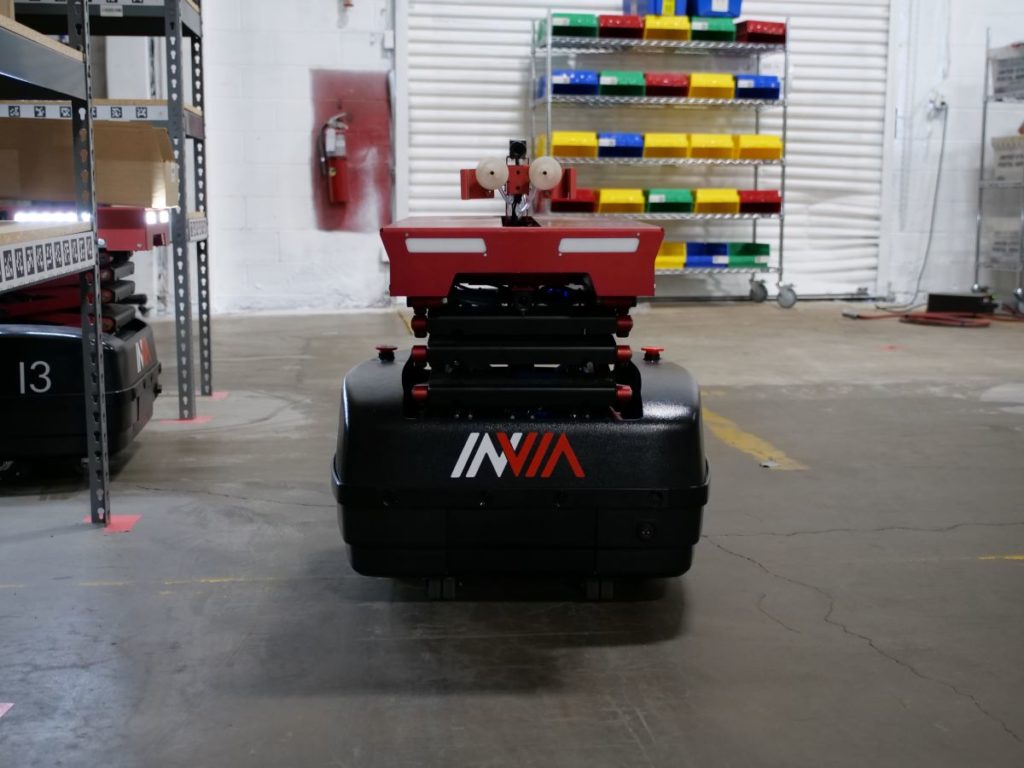
When to Automate Your Warehouse?
You should automate your warehouse when you find yourself struggling with the following:
- You experience order delays due to limited warehouse employees
- Your day-to-day warehouse operations are labor-intensive and take up too much time and energy to fulfill
- You find that you can no longer keep up with the number of work orders that come in every day
- You can no longer keep track of your inventory
- Finding important information causes delays
- Your customer satisfaction and retention numbers start to dwindle
Benefits of Warehouse Automation
The aforementioned issues in your warehouse performance can all be traced back to manual processing. Though you may feel that you should get by with tried and tested methods, oftentimes, outdated processes can no longer keep up with the demands of the modern world. In turn, you experience delays and errors that don’t just hassle your workers but tarnish your reputation as a reliable business or service provider.
If you need more reasons to make the switch to warehouse automation systems, consider the following benefits:
Reduces Operating Costs
Automation is a game-changing technology that will help you reduce operational costs and make your business more efficient. This is done by eliminating human error and giving workers more time to focus on more important tasks.
Boosts Productivity
Even amid a labor shortage, you can maintain a lean team of warehouse workers by equipping them with tools and processes to make their jobs easier. When tasks require less time and effort to complete, workers can do more in a day. On top of this, warehouse automation can reduce safety risks associated with workers rushing, and, as a result, keep workers healthy and happy.
Enhances Inventory Management
When you can monitor your products’ every movement, you can reduce the risk of losing and misplacing items as well as relay accurate information to your customers. This helps to improve customer service and satisfaction as well.
Maximizes Warehouse Space
A lot of warehouse space goes underutilized. By implementing autonomous vehicles and conveyor systems, you can improve the flow of operations in your warehouse and allocate more space for new products, workstations, and the like.
Improves Sustainability
When you can create more efficient workflows, you end up using less energy to keep your facilities up and running. You also minimize wastage, take up less space to run your operations, and lower your operating costs.
The Drawbacks of Warehouse Automation
As helpful as warehouse automation systems are in streamlining operations, they also come with some considerable implementation costs. You’ll have to be prepared to cover the upfront costs of installing machines and software applications, as well as onboarding all your staff. Maintenance and repairs of your robotics and other equipment may also put a dent in your budget, stall your operations for a few hours and cause delays in processing orders.
How to Automate Your Warehouse
To prepare yourself for a warehouse automation solution, follow these steps:
Determine Your Objectives
What do you want to get out of implementing automation? Make a timeline of milestones you want to reach, KPIs to measure, and business goals you want to accomplish by adopting automation for your business.
Put Together an Implementation Committee
Get in touch with all relevant stakeholders, including your operations managers and engineers. You’ll want to know what your warehouse’s capabilities are, what challenges you face and what areas can be improved by introducing new technology. This step will help you identify what kinds of systems will work best for you.
Review Your Inventory Control Systems
Inventory control is a crucial and necessary component of warehouse operations. Before introducing automation into your business, make sure to review and rectify all standard operating procedures related to inventory management, including purchasing materials from vendors, receiving shipments and measuring customer satisfaction.
Implement a Warehouse Management System
A warehouse management system is a software used for monitoring and managing inventory levels, warehouse team productivity, order fulfillment progress and shipping progress. These systems provide managers with real-time updates on the warehouse and their employees’ work performance, as well as important data that can aid them in making more informed business decisions!
Find the Right Warehouse Automation for You
Now, it’s time to put all the information you’ve gathered and figure out the best warehouse solutions for you. Make sure the automation systems you choose align with your customers’ demands and your business goals.
Warehouse Automation Best Practices
To make the most out of your warehouse automation systems, make sure to keep the following warehouse automation trends and best practices in mind:
- Don’t skimp on workforce training. You’ll want to make sure your staff knows how to use your new automation systems, otherwise, what’s the point? Spend a considerable amount of time training them to understand how each system works and how they can make their tasks easier.
- Prioritize finding the right WMS. Don’t underestimate the power of a good, user-friendly, and easy-to-integrate WMS. A good system doesn’t just streamline workflows and centralize data, it also integrates with third-party apps and systems for a more seamless workflow.
- Optimize your warehouse with the Internet of Things. The IoT is a network that connects multiple smart devices within your facility, including sensors, RFID tags, trackers, and the like. By utilizing IoT, you can more easily collect data from your systems and improve your inventory control. Doing so also gives you a constant, real-time view of all operations in your warehouse.
- Take advantage of voice assistants. Help your employees do more by keeping their hands free as they move around your facility. Voice assistants and wireless headpieces make it easier for staff to navigate your warehouse and find everything they need to do their job.
- Consider replacing conveyors with mobile robots. Conveyors are a staple in any warehouse. But new technology is looking to replace or supplement this age-old automation technique. Today, there are mobile robots that can transport goods faster and more efficiently than conveyors, especially since they have more mobility across the entire warehouse floor.
How Much Does It Cost to Automate Your Warehouse?
The cost of automating a warehouse depends on the size and complexity of the project. Generally, though, warehouse automation can cost anywhere between several thousand to millions of dollars.
Key Takeaways
Warehouse automation technology is a great way to improve your warehouse operations. By automating tasks such as order picking, packing, and shipping, you can save time and money while improving your accuracy and efficiency. We’ve outlined the different types of warehouse automation technology and how to automate your warehouse in this post.
Warehouse Automation FAQs
How do I start warehouse automation?
You can start automating your warehouse by implementing a warehouse management system.
What technology do warehouses use?
Warehouses utilize a wide variety of technologies to automate and streamline tasks, including conveyors, shuttles, voice recognition software, autonomous robots, drones, and smart devices.
Will warehouses ever be fully automated?
There is no telling when all warehouses will become fully automated. While the world’s first fully-automated warehouse was introduced in China in 2021, a report showed that over 80 percent of warehouses today do not use any kind of automation at all.
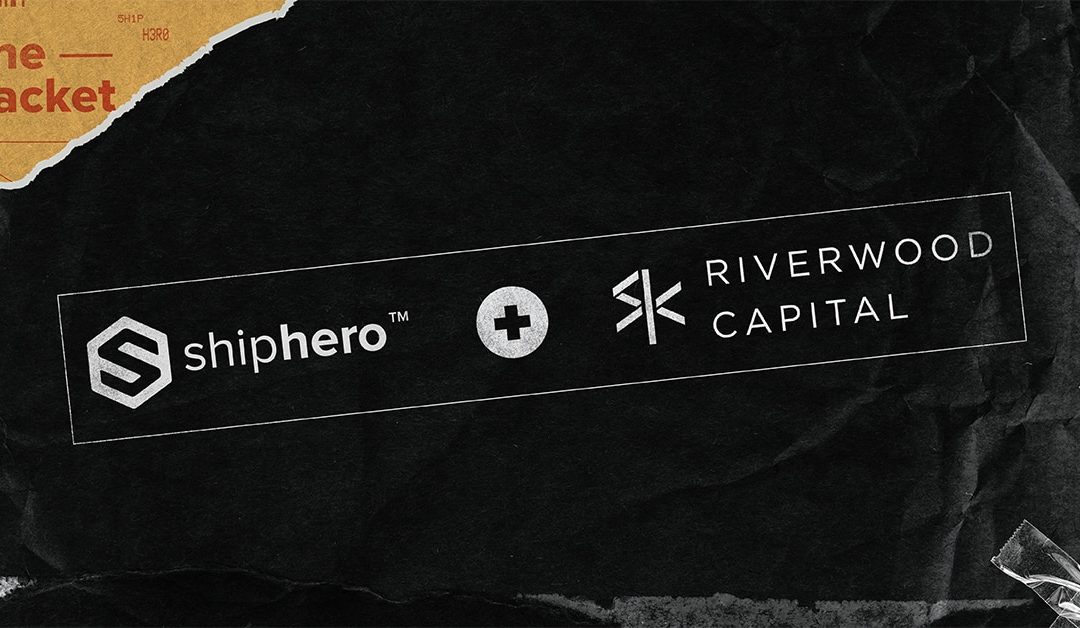
Jun 28, 2021 | Blog, News & Updates, The Packet
ShipHero News
I am excited to announce that ShipHero has raised a funding of $50 million from investor, Riverwood Capital, which will propel our expansion. I am pleased to say that this enables us to serve you even faster, and better – empowering you to achieve growth with your ecommerce business.
This is our first institutional capital and values ShipHero at $225 million. All the funds went into the company, no employees sold stock as part of this transaction and I will retain majority ownership and control of the company.
Where we are today.
ShipHero serves over $5 billion in annual ecommerce orders for thousands of merchants. Over 30,000 merchant employees use ShipHero to do their job every day. We take our responsibility to provide a high quality solution for ecommerce fulfillment seriously. We put our customers first and work to continuously improve ShipHero by offering new features and enhancements that elevate how people define a warehouse management system; quality and reliability are paramount.
What does this investment announcement mean for you?
I am thrilled about what this funding will enable for our customers. The resources give us the opportunity to make your work easier and faster while saving you money.
- ShipHero Software Product Development – We are investing heavily in features, functionality, integrations and quality.
- Coming soon releases:
- PostHero – Free tracking, reporting and analytics on shipping and delivery times for all your shipments with the major US carriers.
- The ability to see a picture of every order as it ships.
- EDI Support via SPS Commerce – Contact your Customer Service Manager (CMS) to join the beta.
- Shipping Containers – Outbound sortation of packages by carrier. Watch the video HERE.
- Live Shipping Board Metrics – Includes the ability to see and export historical data, available now in the Hero Board.
- Advanced FedEx One Rate Support – Contact your Customer Service Manager (CMS) to join the beta.
-
- Coming near term releases:
- ShipHero App Store.
- A native Netsuite integration, which will be our first ERP integration.
- Xdelivery carrier integration.
-
- Longer term releases:
- Guided putaway.
- Smart replenishment. We’ll prompt you to put fast movers in locations you designate as easy to pick from.
- A full redesign of our mobile app to improve ease of use.
- PO receiving on our mobile app.
- Faster label generation.
- Weighted average value of on hand inventory.
- ShipHero Fulfillment Expansion – We offer ecommerce fulfillment that is faster, cheaper and lower carbon out of our own warehouses in Allentown, PA, Dallas-Fort Worth, TX and North Las Vegas, NV, learn more HERE.
- We are under contract to add an additional 400,000 sq ft of owned and operated capacity which includes the addition of a facility in Jacksonville, FL. We will continue to grow the size and number of facilities to support our customers.
Thank you to our employees and customers.
The fundraising is a result of the work we’ve done as a company. Thank you to everyone at ShipHero for doing your best work. I appreciate you.
Thank you to our customers. We only exist because of the faith you put in us and we only grow because of the good things you tell other business owners about us.
With gratitude,
Aaron Rubin
Founder & CEO, ShipHero

Nov 15, 2023 | Blog

It’s time to finish up that holiday shopping! We’re highlighting some of our favorite clients and their favorite items for gifting. Check out the goodies below and click through to round out your gift list.
Aruba Aloe
Founded in 1890, Aruba Aloe is one of the few Aloe companies in the world that grows, harvests, and processes its own Aloe on-site.

Aruba Aloe Special Care Lotion 2oz
An Aruba Aloe cult classic! Intensely hydrating and with an extra infusion of Vitamin E, this lotion is also blended with Pure Aloe Vera from Aruba and moisturizing Jojoba Oil to replenish dry, irritated skin and help keep skin soft and supple.
DFTBA – Awesome Coffee Club
A coffee subscription you can feel good about! We source the best beans from small farms in Columbia, send them to you on a regular schedule, and 100% of profits are donated to radically reduce maternal and child mortality in Sierra Leone.

Octavia *Medium-Dark Roast*
Octavia is a rich, well-balanced, medium-dark roast of Arabica beans. With tasting notes of dark chocolate and a hint of molasses, Octavia elevates your everyday coffee to truly awesome. Buy individual bags, or subscribe to save 12% each month, and an additional 25% off your first order!
Momofuku
Momofuku Goods gives home cooks access to restaurant-grade products that make cooking more accessible, fun, enjoyable, and delicious.

Momofuku Chili Crunch
Meet Momofuku Chili Crunch. This spicy-crunchy chili oil is our go-to way of adding a flash of heat and texture to our favorite dishes.
Developed by David Chang and the Momofuku Goods team, Chili Crunch is restaurant-tested and the result of a decade of research.
With three types of Mexican chilis, crunchy garlic and shallots, Chili Crunch is the perfect balance of spicy and crunchy.
Hundreds of 5-star reviews agree that it’s great for spicing up dips, eggs, noodles, BBQ, and more.
Nomad Cosmetics
Nomad Cosmetics offers beauty products inspired by captivating destinations from around the world for those that love to explore and discover.

Nomad Air Frequent Flyer Beauty Essentials Collection
Dreamed up in the air! Introducing our new Nomad Air 4-piece skin care and make-up collection. These beauty essentials blend the best of what nature has to offer with science-backed innovative ingredients for clean formulas that counter the effects of frequent travel. There’s no added dyes or fragrances – just ultimate hydration – in aircraft-inspired aluminum packaging that is plastic-free.
The Season is Upon Us
Finish up that holiday shopping with these unique and special items available from our valued customers. ShipHero prides itself on working with brands and 3PLs that strive for the best in service and customer satisfaction. Our WMS works as the ultimate warehouse operating system to make it easy for all of our customers to run more cost-effective and efficient warehouses. Our full-service fulfillment solution takes away the headache of managing your own DTC and wholesale fulfillment so you can focus on truly building your business.
If you’d like to learn more about how ShipHero can make your DTC, 3PL or Wholesale life easier, reach out today!

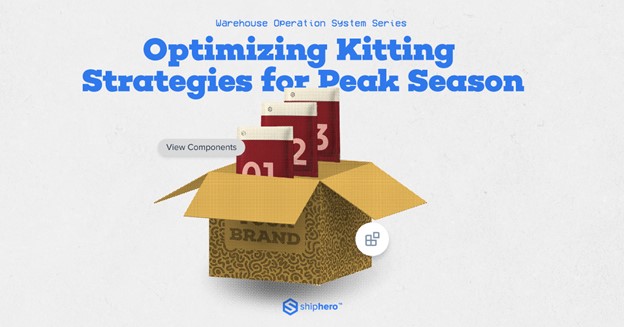
Oct 20, 2023 | Best Practices, Blog, Fulfillment, Warehouse Management Software, Warehouse Operations
Optimizing Kitting Strategies for Peak Season | Warehouse Operations
Are you feeling the pressure of peak season looming over you? We’ve been in your shoes and we know how to make it easier. We’ll dive deep into how you can improve your kitting services to boost your bottom line, from examining your warehouse layout to implementing practical automation rules.
We also consulted a few kitting pros, Alex Lewkowict of One23 Fulfillment and ShipHero kitting superstar Heather Schwartz, Director of High Touch Fulfillment, PBI, for insight into how to make kitting work for you. Let’s get kitting!
Why Kitting Matters During Peak
Kits offer best-selling products in one attractive package at an irresistible price. Customers love the convenience of these ready-made gift options (especially during the holidays), making them an easy one-click purchase. By promoting kits, eCommerce businesses can drive sales rapidly and effortlessly. With a little pre-planning, you can meet your client’s needs without hassle in your warehouse. Make sure everyone stays merry and bright!
Kitting Preparation | Before Peak
The Warehouse Layout Dilemma
Efficient kitting preparation is essential for businesses to meet peak season demands. One of the significant challenges of kitting is determining the best warehouse layout. Without a defined strategy, warehouses can end up wasting valuable space and manpower, which can lead to delays and errors throughout the shipping process. Planning ahead is essential to optimizing your physical layout for a kitting system that minimizes risk.
Balancing Disruption vs. Efficiency
It may be worth considering a dynamic “hot” pick zone to balance disruption and efficiency in your warehouse. By analyzing your SKU velocity, you can quickly identify the best locations for your fastest-moving items and create a designated area to improve efficiency.
This approach can be beneficial for high-volume items with low SKU counts and items frequently promoted by your marketing team. By implementing a hot pick zone, you can take control of your warehouse operations and streamline your processes for improved productivity and profitability.
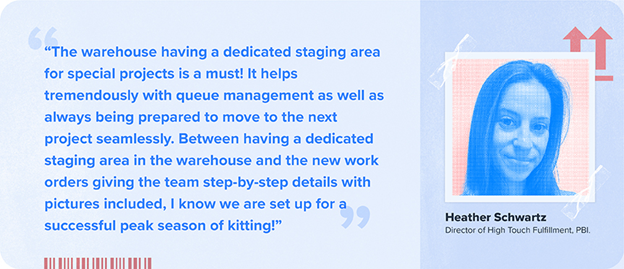
Change is Good
Alex Lewkowict overcame challenges managing kitting demands during past peak seasons by changing the kitting processes in the warehouse. One of his most notable changes was creating a dispatching station outside the pack line to streamline the packaging process.
Additionally, he constructed a more efficient pick wall using three shelves and 17 SKUs to handle the volume effectively. This allowed for quick replenishment of inventory behind the pick wall and placement of products in a temporary pallet location for easy access.
As a result, up to 500 items per hour were processed, and the need for an additional picker was eliminated. With Alex’s approach to identifying and addressing bottlenecks, kitting processes at One23 Fulfillment have a near-zero error rate at peak season.
Kitting Training for Peak
Identifying essential skills can make or break a company’s success. For example, Alex flew 10 people out from his Palm Beach warehouse to assist Las Vegas with the sudden surge in demand, exemplifying the importance of adaptability.
By recognizing the strengths of the East Coast warehouse and shifting resources accordingly, Alex was able to maintain a 95% success rate in fulfilling orders within 24 hours. This kind of strategic thinking is essential in navigating the ever-changing landscape of modern business.
Training Programs and Methods
From safety protocols to customer service, employees should be equipped with the knowledge and skills to handle various situations. Properly trained staff can uphold the company’s standards, minimize risks and ensure the satisfaction of customers.
Communication is critical, as Alex noted after visiting other warehouses where employees didn’t understand the significance of the peak season. It is crucial to ensure that your team is fully equipped to handle the increase in volume while still providing top-notch service.
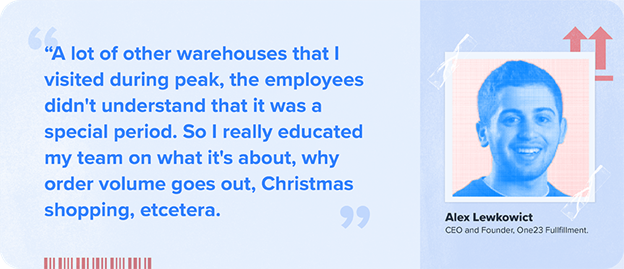
Kitting Preparation | During Peak
Kitting Strategies
As we’ve learned, don’t make drastic changes during peak season. You want to do your best to avoid bottlenecks, delays, and damages during this time. Kitting is huge for your clients, and knocking it out of the park is essential. You can optimize your kitting process and increase transparency with technology like:
- Warehouse Management System (WMS)
- Barcode and RFID Tags
- Mobile-Powered Carts
- Automated Picking Tools
- Batch and Lot Tracking
The combination of mobile carts and barcodes or RFID tags with an inventory management system can significantly expedite the process.
Just-In-Time Kitting
Effective kitting strategies are critical for managing supply chains during peak seasons. One such strategy that has proven successful is Just-In-Time (JIT) kitting. By assembling kits in the warehouse and delivering them as needed, businesses can be more responsive to demand while keeping inventory levels low. This approach can also streamline processes and make it easier for 3PLs to adapt to changing circumstances.
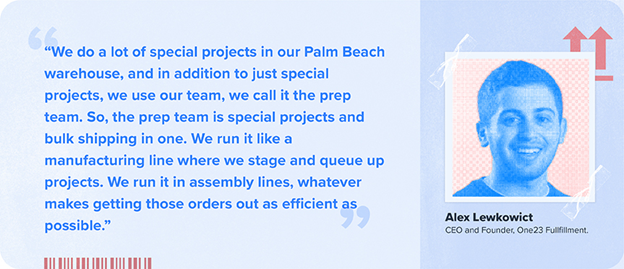
Automation Rules
Automating your kitting system helps you use your warehouse space and resources better and leads to faster product completion and delivery. An automated system eliminates the guesswork for your pickers and packers, ensuring they can complete their tasks quickly and accurately every time.
Focus Areas for Automation
ShipHero’s WMS automation is a straightforward way to automate your warehouse.
- Inserts and Packaging
- Include a warehouse note with orders that contain SKUs that require extra instructions for packaging.
- The Box Type Selection feature is handy when handling fragile items that require special packaging.
- You can include inserts here, such as thank-you notes and coupons.
- VIP Handling
- You can add a gift SKU or marketing insert to these orders, provide express shipping, and prioritize those orders on the day they need to be shipped.
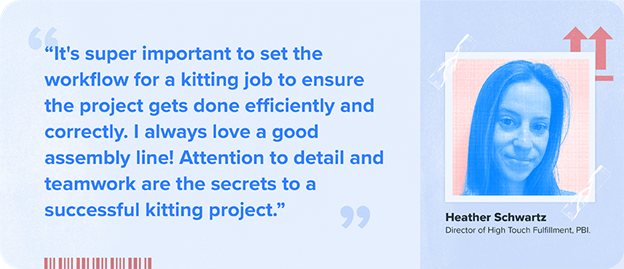
Kitting Preparation | After Peak
Post-Peak Assessment and Adjustments
Once the pressure of peak season ends, start thinking of reverting changes made to your warehouse during the peak rush.
This means moving items that were temporarily placed closer to packers back to their original positions and considering whether kitted items need to be disassembled and put back into their original inventory areas. Strategic reorganization of your warehouse layout through redesign is a big undertaking, but it is necessary for adapting to ever-changing market demands.
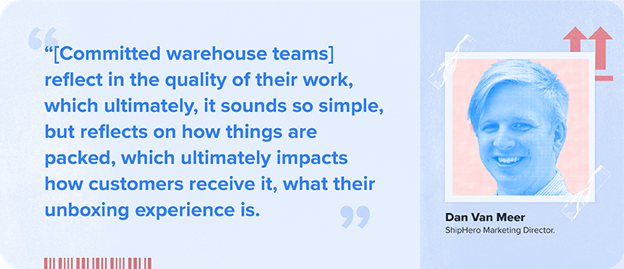
Warehouse Kitting Success
Kitting requires strategic planning and thoughtful execution, considering preparation for items like warehouse layout, employee training, automation rules, and strategic reorganization. Following our advice, you can make this peak season a successful experience.
You now have all the tools to effectively streamline your kitting services for peak season. You can ensure that the process runs smoothly with hard work and dedication. Take charge of your success and start taking action now. Don’t let this opportunity slip away; make this your most successful year yet!
Key Takeaways
- Planning ahead is essential to optimizing kitting services for peak season demands by considering all aspects of the warehouse layout.
- Consider a dynamic hot pick zone to balance disruption and efficiency in the warehouse.
- Implement changes such as creating dispatching stations outside pack lines and more efficient pick walls to improve productivity and profitability.
- Train staff properly on safety protocols, customer service, and the importance of proper preparation.
- Just-in-time kitting is an effective strategy for managing supply chains during peak season.
- Automating your kitting system can expedite product completion and delivery.
- Revert changes made during peak back to their original positions post-peak.

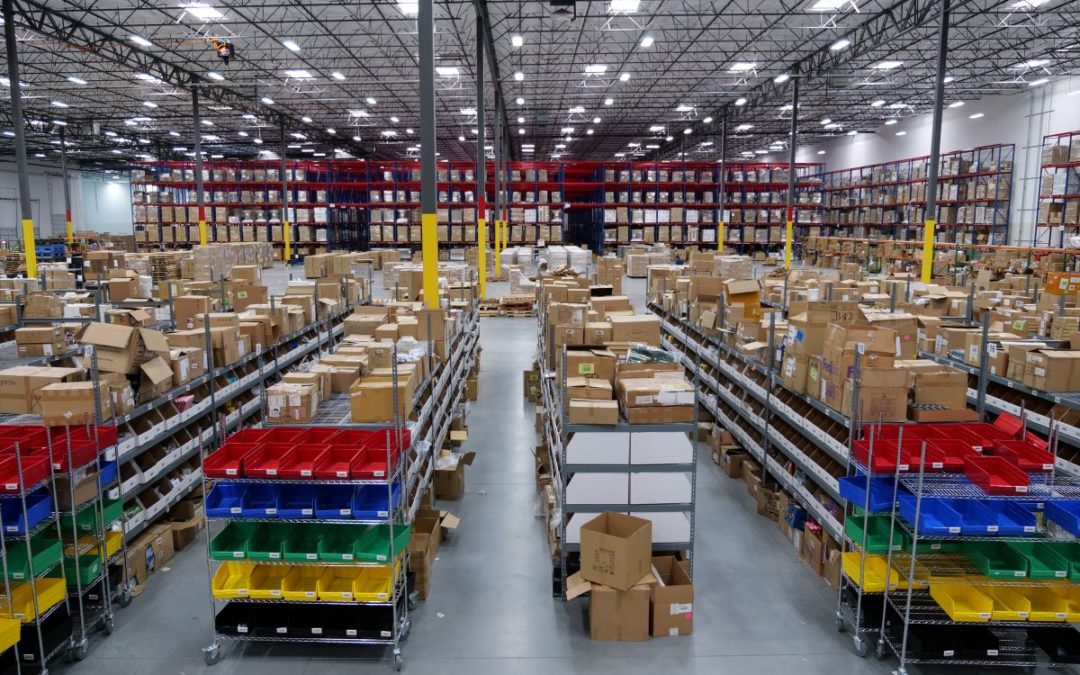
Mar 23, 2021 | 3PL Warehouse Management, Article
Third-party logistics (3PL) is one of the ways that a company can outsource order fulfillment. An eCommerce order fulfillment process starts when a customer submits the order and finishes when the product reaches their door.
What seems like a simple process can become quite complex depending on the storage location of your company’s inventory, the customer’s location, the size of the order and the timetable for delivery. It becomes even more complicated when you factor in the potential for returns.
Suppose you can’t handle your eCommerce fulfillment in-house. In that case, it’s probably time to outsource and let a third-party logistics company take over.
Keep reading to learn everything you need to know about 3PLs.
What Is a Third-Party Logistics Company?
3PL companies are companies that offer various eCommerce logistics processes to online businesses. Some services they offer include warehousing, inventory management and order fulfillment.
3PL involves the business, the logistics provider and the shipping carrier. In simple terms, a 3PL provider offers logistics services to manage certain aspects of a company’s shipping operations. 3PLs are renowned for their logistics industry expertise and can help companies better fulfill orders to keep their customers happy.
Some people think 3PLs and freight brokers are essentially the same. However, 3PL companies are more active than freight brokers because they take over your fulfillment operations. Meanwhile, freight brokers only connect you to shipping carriers without touching your products.
A 3PL becomes integrated into the company’s inventory storage and transportation procedures. Rather than storing, packaging and shipping orders, companies hire a 3PL to manage the entire process. The 3PL owns or leases its storage and transportation assets to fulfill the client’s orders remotely, ensuring you can focus on growing your business.
Third-party supply chain models first appeared in the 1970s when intermodal marketers took packages from businesses and brought them to rail stations for delivery. People developed 3PL software to help companies manage inventory and deliveries as the field grows. Nowadays, all kinds of businesses, from Fortune 500 to small businesses, use third-party logistics.
Benefits of Third-Party Logistics in Supply Chain Management
Here are the benefits of working with a 3PL company:
Reduce Logistics Costs
Third-party logistics companies often have connections in the sector, meaning they have better access to vendors and can negotiate higher discounts for you. By partnering with them, you can use their contacts and influence to reduce shipping supply and warehousing expenses, ultimately saving you money.
Receive Logistics Experience
Many third-party logistics service experts have decades of combined experience in the industry. When you hire a 3PL company, you get access to this expertise to get insights on transport documentation, shipping regulations and other logistics issues. They can also answer your questions about how to increase operational efficiencies.
Focus on Critical Functions
Running an in-house logistics division takes a lot of time and money. By hiring a 3PL company, you can instead focus on core business processes like developing marketing materials and improving sales channels. Better yet, you can do this without dedicating any internal staff or resources to run an in-house logistics division.
Scale With Your Business Capabilities
3PLs provide custom-made services based on your company’s needs and performance. If your business grows and product orders increase, you can sign them for a more significant contract with more benefits. Conversely, considering downscaling your business, you can opt out of some of their services.
Increased Speed
Working with a 3PL company helps you save time. You save time not only by streamlining various supply chain operations but also by being proactively aware of any potential issues in the supply chain. Addressing these issues early on means you don’t need to spend a lot of time fixing them after the damage is done.
Shipping and Logistics System Connectivity
Many 3PL companies offer all-in supply chain and logistics management, which means they handle your entire supply chain. This means your entire supply chain and logistics operation is handled by one party, reducing the chance of miscommunication and mistakes. It’s also more efficient since all the information flows within one organization instead of many.
Improved Customer Service
Customers want to get their purchased items on time. Working with a 3PL company helps you get products to customers on time, increasing their satisfaction. Many 3PL companies also offer returns management, restoring customer satisfaction when they receive defective items.
Third-Party Logistics Business Model
As the name implies, 3PL involves three parties that help bring products to the market. Here are the three parties involved in the 3PL model:
The Business
The business is your company – you’re responsible for producing goods and running the eCommerce business. Once people buy your products, you send the orders to your logistics company.
The Logistics Company
The logistics company is the intermediary between your company and the shipping providers. Third-party logistics companies offer many services, including warehousing, packaging and inventory management.
The Shipper
The shipper carries your products to physical stores or the buyers’ doors. Major shippers include USPS, UPS and DHL.
What Services Does a 3PL Provide?
A 3PL can scale and customize its services according to the client’s specific needs. The client still retains some oversight when managing shipping operations. Before signing a contract, you can outline what services you want the 3PL to provide and what services you will maintain in-house. As your business grows, your 3PL provider can take over a significant role in expanding your supply chain and procurement operations.
Here’s an overview of the services a 3PL typically provides:
Product Storage Solutions
3PL companies provide warehouse spaces to handle order fulfillment for multiple companies in one place. This improves efficiency and reduces costs because they don’t have to switch between numerous warehouse locations to finish orders. Moreover, you don’t have to lease warehouse space, buy forklifts, or rent trucks to handle your merchandise.
Inventory Management and Organization
Managing inventory involves more than simply storing your company’s products. Integrative technology also syncs your inventory with your online store in real-time, so you can track inventory and predict demand to avoid sell-outs. Your 3PL also helps organize items with multiple parts into proper categories, ensuring nothing is misplaced.
Inventory Distribution
Most 3PL providers have fulfillment centers across the country to store your products. 3PL companies distribute your inventory across the country to ensure fast shipment times.
A 3PL automatically routes orders to fulfillment centers based on the customer’s location. 3PLs use extensive automation to save hundreds and thousands of dollars on inventory distribution, raising their clients’ profits.
Picking and Packing
Alongside storage, 3PL companies assign staff to pick products for each order and package them for delivery.
Freight Forwarding
Once the products are picked and packaged, the 3PL forwards them to a shipping carrier for delivery. Different 3PLs work with other carriers, and a good 3PL will choose the one that offers the best price and delivery speed. Some 3PLs even work with local carriers for less than truckload (LTL) shipping for local orders.
Expedited Shipping
By partnering with a 3PL, your company can offer expedited shipping options to your customers since fulfillment centers send out orders daily. 3PLs often negotiate discounts with carriers like FedEx, DHL, USPS and others to offer faster delivery speeds at a manageable cost.
Shipment Tracing/Tracking
In addition to handling the shipping process, a 3PL will also manage the tracing and tracking process. Customers will receive shipping information to track their orders throughout the fulfillment process.
Reverse Logistics (Returns)
Not only do 3PLs offer shipment services, but they can also provide reverse logistics to handle returns. A 3PL can provide customers with return labels to drop the item off with a carrier for return to the fulfillment center.
Again, when you sign a contract with a 3PL company, you can customize its services according to your business’s needs. An experienced 3PL provider will be able to handle the logistics of the entire supply chain from when your customer submits their order to when it arrives on their doorstep.
How 3PLs Handle Order Fulfillment
So you can visualize what this looks like, here is an outline of the order fulfillment process from a 3PL provider’s perspective:
Step 1: Receiving
A 3PL needs inventory to complete customer orders, so your first act should be moving inventory to their warehouse. Depending on your business size, your inventory may be divided into several fulfillment centers. Each 3PL has its process for receiving and storing inventory. Most providers can customize this service according to the client’s needs.
Step 2: Picking
Depending on the 3PL’s software, your partner may get the orders automatically, or you may have to send them manually. After placing the order, the 3PL starts the order fulfillment process by packing the items at the warehouse and then passes it to the next stage of the supply chain for packaging.
Step 3: Packing
Once the 3PL has picked up all ordered items, they are prepared for delivery.
Standard shipping materials for your products include cardboard boxes, poly mailers, bubble wrap, packing tape and bubble mailers. The best 3PL company can balance package protection and small dimensional weight so your products arrive safely and within budget.
Some 3PL companies charge extra for packing material, but others fold the costs into the service fee. Depending on your working relationship, 3PL companies may also let brands customize their packaging.
Step 4: Shipping
After the products are prepared, they’re handed off to a courier for final delivery.
Some 3PLs partner with specific shipping carriers, while other companies have a rotation of transportation services to get the best deals. Either way, 3PL partners are responsible for brokering deals with freight forwarders to bring you the best rates. The courier fleet usually picks items up from your 3PL partner’s warehouses.
Step 5: Returns
The order process doesn’t always finish once the package is delivered to the customer’s door. Specifically, product returns can get complicated if you manage inventory stock levels yourself. When you’re working with a 3PL partner, they receive all returned products to be restocked, scrapped, or processed.
To make the return process more manageable, you can ask the 3PL company to provide shipping labels for every package. Customers can fill them out and return their packages if something goes wrong.
It should be clear by now that 3PL partnerships benefit companies, but how do you determine whether yours will? Keep reading to learn the signs that it’s time to hire a 3PL.
When Do You Need a 3PL?
3PLs are needed when you can’t handle order fulfillment by yourself. Unless you’re running a small retail business out of your garage with no more than a dozen orders a week, the chances are good that your company could benefit from hiring a 3PL provider. To help you decide, here is an overview of the advantages associated with working with a third-party logistics provider:
- Time savings: Outsourcing your company’s logistics means you have more time to focus on critical business processes.
- Cost savings: 3PL companies offer lower warehousing, shipping and inventory management prices, which is cheaper than building in-house logistics departments.
- Improved compliance: 3PL companies help you stay updated with the latest logistics technologies and regulations. Service customization: When it comes to warehousing, shipping and distribution, a 3PL provider can customize its services according to your needs and adjust as you grow. Access to resources: Hiring a 3PL gives you access to the best inventory management software and other integrative technology you might not get on your own.
- Expanded reach: 3PL companies have more experience negotiating with shipping carriers and other vendors so that you can get the best logistics services at low rates.
- Risk reduction: Outsourcing operational logistics to a 3PL company means fewer labor and financial risks than building an in-house logistics department.
Still unsure whether hiring a 3PL provider is the next logical step for your business? Here are some of the top reasons to hire a third-party logistics provider:
You’re Shipping More Than 100 Orders Per Month
There is nothing magical about the number “100” – the point is that your company is receiving more orders than you can efficiently manage in-house. Shipping a large volume of items per month means your team spends more time and effort fulfilling orders than doing core business tasks. Once you’ve reached over 100 shipments per month, it’s a good idea to hire a 3PL company to support your operations.
You’ve Run Out of Storage Space for Your Inventory
Any retail company’s goal is to have enough orders that it becomes necessary to increase inventory levels. Of course, when this happens, you’ll need space to store all of that extra inventory. Rather than dealing with this predicament each time you add a new product to your store, turn over storage logistics to a 3PL.
You Want to Offer Your Customers Expedited Shipping
Suppose you’re currently managing your order fulfillment in-house. In that case, you may struggle to make it to the post office even once a day, let alone often enough to give your customers expedited shipping options. With a 3PL handling your order fulfillment logistics, you can suddenly offer one-day, two-day and maybe even same-day delivery.
You Want to Save Money on Storage and Shipping
Working with 3PL providers isn’t cheap, but it could save you loads of time and money. Instead of spending a lot to lease storage space and build an in-house logistics division, consider hiring a 3PL so you can spend the savings on building your business. Additionally, 3PL services speed up product deliveries and give you a competitive advantage.
You Want Your Company to Have Room to Grow
Every good business person is forward-thinking. From the moment you start your business, you should know where you want to go and how you want to get there. Suppose you expand your offerings throughout the country or around the globe. In that case, a 3PL can help you get there with inventory distribution services. For example, some 3PLs can leverage 2-day or overnight shipping to help eCommerce businesses keep up with Amazon and other giants.
Hiring a 3PL provider to manage your supply chain’s logistics is smart if any or all of the signs above are coming into play. Before you start shopping around for a 3PL, however, you should take a moment to consider whether doing so is enough. You may want to consider taking things one step further and hiring fourth-party logistics service providers – keep reading to learn more.
What’s the Difference Between a 3PL and a 4PL?
First and foremost, you should know that 3PLs and 4PLs are professional, hired services that help businesses like yours plan and execute inventory management and order fulfillment logistics. You get much more flexibility than you would if you managed fulfillment in-house.
As you well know by now, a third-party logistics provider is a company that handles the logistics of your company’s supply chain and order fulfillment processes. Depending on how much control you want to hand over to your 3PL, they can do everything from storing and managing your inventory to picking, packing and shipping your orders. They can even handle the returns management process for you.
So, what is a fourth-party logistics provider, and how does it differ from a 3PL?
A fourth-party logistics provider adds another element to the equation, combining various resources and technologies to optimize your supply chain’s design and execution. You can still keep your 3PL to manage the day-to-day details of order fulfillment. Still, a 4PL will become the “control tower” that oversees supply chain management. They will supervise your 3PLs and any other resources or providers you use to ensure your supply chain operates smoothly, efficiently and cost-effectively. For businesses that want total supply chain visibility, a 4PL provider can be a great option.
The critical difference between a 4PL and a 3PL is that many 3PLs are asset-based – they own or lease equipment and warehouses that they use to provide services. As such, a 3PL is concerned with its costs and may not always seek the best deal for you if it means a better deal for them. In contrast, a 4PL’s only concern is integrating and optimizing your supply chain operations.
The Different Types of 3PL Providers
A third-party logistics provider can offer many services, though many focus on specific supply chain solutions. As a business, this might mean hiring multiple 3PLs to fulfill your supply chain’s different aspects – this is when hiring a 4PL may come in handy.
Here is a quick overview of the different types of 3PL providers you may come across:
Transportation
As part of your transportation 3PL search, you need to consider several factors, including the company’s location, where your customers are located, delivery timelines, shipping methods, service options and pricing and discounts. This type of 3PL deals with shipping inventory between locations.
Warehousing/Distribution
The most common type of 3PL is warehouse and distribution-based. These providers handle the storage, shipment and returns of your orders. When considering a warehousing 3PL, you’ll need to consider the number of locations and their geographical locations, the pricing model for storage, negotiated shipping rates, delivery insurance, daily cutoffs for order fulfillment and management tools.
Financial/Information
Once your company expands beyond the eight or nine-figure mark in annual revenue, you may want to bring a financial 3PL on board to help you optimize your operations for the industry and to evaluate current trends. These 3PLs offer freight auditing, cost accounting, bookkeeping, tracking, tracing and inventory management.
How 3PL Pricing Models Work
Now that you better understand the different types of 3PL providers, you may wonder how much it costs to hire a 3PL. Third-party logistics pricing depends on the services you require and the scope. Several factors that determine 3PL pricing include:
- Onboarding: Getting a 3PL partnership up and running can take 3 to 6 months, so some companies charge onboarding fees to set your company up with integrated technology to manage order fulfillment services.
- Inventory Receiving: Before a 3PL can start managing its supply chain, it must receive its inventory from suppliers or manufacturers. Some companies charge per unit or pallet, while others charge by the hour or a flat rate for receiving and storing inventory.
- Inventory Storage: Different 3PLs offer different storage fees depending on the warehouse. You may be charged a lower rate for shared storage but will share the fulfillment center with other companies. You may be charged per item, bin, shelf, or pallet for storage.
- Order Picking and Packing: Many 3PLs charge a fee for picking each item, while others include this cost in the total order fulfillment price. Some companies offer discounted rates for orders under a certain number of items.
- Packaging: Some 3PLs include packaging materials in their shipping costs, while others charge a fee. You may have the option to customize your packaging materials, or you may not.
- Kitting: Refers to any unique accommodations you request for assembling, arranging, or packing orders before shipping. Assembly fees vary according to your individual needs.
- Shipping: Most 3PLs have relationships with shipping carriers to reduce costs, which means more significant savings. These costs consider various factors, such as shipping speed, shipping zones and packages’ dimensional weight.
In addition to considering these individual costs, you should also know that most 3PLs offer three pricing models. Here is a quick overview of their differences:
- Total Fulfillment Cost: This pricing model reflects the total fulfillment cost for direct-to-consumer orders, charging only for receiving, storing and shipping inventory instead of fees for individual services.
- Fulfillment by Amazon: Abbreviated to FBA, Fulfillment by Amazon is a model in which products are sold on the Amazon marketplace, and Amazon fulfills orders on behalf of your company. Because Amazon receives a cut of every sale, they can offer discounted fulfillment fees. This offer is convenient for some companies, but for others, it means sacrificing a portion of their bottom line and losing the ability to highlight their brand. Amazon also charges long-term storage fees for unsold items.
- Pick and Pack: As you can guess from the name, this pricing model is based on separate charges for each item picked and packaged. Most 3PL providers charge between $0.15 and $5.00 for each pick, so costs can add up quickly with this pricing model.
When choosing a 3PL provider, consider all aspects, including costs. Keep reading to receive some additional tips for selecting a 3PL provider.
Tips for Choosing a 3PL Provider
If you’ve decided that hiring a third-party logistics provider is the next logical step in expanding your business, congratulations! Now comes the hard work – choosing the perfect provider to meet your business’s current needs while offering room for growth.
Here are some simple tips to keep in mind when choosing a 3PL provider:
- Ask the provider if they have an enforceable non-disclosure agreement (NDA).
- Look at the company’s financial stability and client satisfaction track record.
- Book a consultation to visit a nearby 3PL warehouse or distribution center to see if their operations are up to code.
- Consider the company’s hours of operation, including weekends and holiday hours.
- Ask what services the company provides and which, if any, they consider their specialty.
- Determine what third-party logistics software they use and examine its features.
- Ask how the company differs from other 3PLs and what differentiates them from the competition.
- Consider the options for customization and scalability of services.
- Inquire about their relationships with shipping carriers and their negotiated rates.
- Ask about their options for expedited shipping as well as guaranteed deliveries.
- Determine how many warehouses they operate and their locations.
- Ask about their customer service policies and how they help you when an issue occurs.
- Ask what the costs and process is. If you’re not happy, choose to switch to another 3PL.
- Find out what their typical customer profile is. If their profile is disjointed or you’re not similar to their other customers, they might not be the right 3PL.
- Try to find reviews and talk to existing or past customers.
Mistakes to Avoid When Choosing a 3PL Provider
Naturally, you want to find the best 3PL provider for your company. That’s probably easier said than done, though. There are many pitfalls to avoid when choosing a 3PL company to work with.
Here, we’ll cover six mistakes you should be wary of when picking a 3PL company.
Choosing Companies With the Lowest Upfront Costs
One of the goals of outsourcing fulfillment is saving money, but that doesn’t mean you should cheap out on a 3PL company. You shouldn’t choose a 3PL company just by choosing the one with the lowest upfront costs because it may cost you more in the long run.
Many 3PL companies can offer low upfront costs because they don’t use the latest technologies or provide less client support. If your chosen 3PL company isn’t doing its best to satisfy your logistics needs, your customer satisfaction may also suffer. Consider spending more upfront to gain long-term benefits instead of short-term savings.
Not Asking Questions
Just like any partnership, you need to be clear about what you expect out of your 3PL partner. Here’s what you should do before signing a deal:
- Ensure you know how the 3PL company runs its business.
- Ask the representative questions about how the company handles big order volumes, scales for seasonal demand, receive customer returns and more.
- Don’t move forward with the deal before you know everything you need to know about the 3PL provider.
Choosing 3PL Companies Closest to Your Location
Choosing a 3PL company with fulfillment centers close to you means you’ll have an easier time surveying your inventory and checking out its operations. But it’s even more important that your 3PL’s fulfillment centers be close to your customer base to reduce shipping time and costs.
Not Communicating Product Demand Changes
3PL companies don’t understand your business unless you tell them, so you need to inform them of any changes in seasonal demand. They may have difficulty managing inventory if you don’t communicate when your products are most or least in demand. Remember to give your 3PL partner advanced notice of demand spikes to ensure they have enough inventory on hand to meet customer demands.
Not Providing Relevant Information
Communication is key when working with a 3PL partner, and sharing information relevant to your logistics operation is part of it. You need to trust your 3PL partner with essential information about your logistics operations, so they won’t be in the dark and can provide the best services.
Picking 3PLs With Bad Client Service
Your interview with a prospective 3PL partner generally informs how they run their business. If the representative exhibits a customer-first attitude and goes out of the way to accommodate your needs, that can be a good sign of how they’ll treat your customers. Conversely, if the representative treats you badly, the company may do the same to your customers.
Examples of 3PL Companies for eCommerce and Small Businesses
There are dozens of 3PL companies vying for your business, so choosing one is challenging. To help you decide, here are four premiere 3PL company options for your eCommerce and small business:
ShipHero
ShipHero is one of the best third-party logistics services for online retailers providing order fulfillment for more than 4,000 eCommerce businesses. Here are some of the benefits you’ll get when partnering up with ShipHero:
- Warehouse management services
- Robust 3PL software system
- Nationwide fulfillment center network
- Professional returns management
- eCommerce platform integration
- A variety of delivery options
- Simple pricing model and flat fees
- No-contract services
ShipHero also integrates with major eCommerce platforms like Shopify Plus, BigCommerce, Shopify, Amazon and WooCommerce.
ShipBob
ShipBob is a third-party logistics company that helps you ship products worldwide. It promises shipping to all areas of the world through fulfillment centers in North America, Australia and Europe.
ShipBob offers these 3PL services:
- Warehouse storage
- Pick and pack
- Product receiving
- Standard product packaging
- Product shipping
ShipBob offers integrations with major eCommerce platforms like Shopify, BigCommerce and Squarespace.
Whitebox
Whitebox offers end-to-end 3PL services to help your products go from the factory floor to the buyers’ doorstep. Whitebox even has an in-house advertising agency to help you market your business.
The services offered by Whitebox include:
- Product packaging
- Shipping
- Quality assurance
- Warehouse management
- Order fulfillment
- Product description creation
- Professional product photography
FedEx Fulfillment
FedEx Fulfillment is the 3PL subsidiary of FedEx, which offers third-party logistics to small businesses. It boasts excellent customer service and a resource hub to help new business owners learn entrepreneurship.
Here are the services you’ll get from FedEx Fulfillment:
- Order fulfillment
- Product packaging
- Reverse logistics
- Warehouse and storage management
How to Choose the Best Third-Party Logistics Company
Choosing the right 3PL company can help you cut costs and improve efficiency. Follow these tips to pick the right 3PL provider:
- Research the company’s reputation and track record.
- Find a company that offers all the services you need.
- Look into the 3PL company’s technology.
- Ask about their inventory and packaging customization offerings.
- Pick a company that provides multiple fulfillment centers across your target regions.
Closing Thoughts
Once you’ve narrowed your list to a few different 3PL options, it’s time to start digging deeper to find the best match for your company. Before talking to any 3PL in-depth, ensure they have and sign a non-disclosure agreement to protect your company.
In addition to talking to the 3PL’s representatives, you should also ask for references in the industry to determine whether the company has a solid track record and a positive reputation. Over time, it will become clear whether any of the 3PLs on your list are the right fit for your company or not.
Of course, the most important matter when choosing a 3PL partner is the value it offers. Find a 3PL company that caters to your order fulfillment needs at a reasonable price.
Finding the perfect third-party logistics partner that will keep your company’s best interests in mind may not be a quick and easy process. Still, it is important that you do it right.
For help finding a 3PL provider, check out our online directory or contact ShipHero directly to learn how we can help you with fulfillment.

Third-Party Logistics FAQs
How Is a 3PL Different From a Fulfillment Company?
A 3PL is different from a fulfillment company in the services it offers. Most fulfillment companies only pack and ship your packages. Meanwhile, a 3PL company takes over your entire logistics operations, from warehousing to shipping. Many 3PLs even offer extra services like returns processing and inventory management.
3PL Companies for Small Businesses vs Large Businesses
3PL companies can help small businesses and large businesses alike. The scale of service is the major difference between 3PL for small and large businesses.
For small businesses, a 3PL company may only need to handle a relatively small amount of items with limited variety. Conversely, 3PLs working with large businesses may handle a wide range of products at larger volumes.
That said, the end result is still the same. Partnering with a 3PL increases your logistics efficiency to save money and get products to customers quicker.
What are third-party logistics (3PLs)?
Third-party logistics involves handing your logistics operations over to another company. A third-party logistics company usually offers warehousing, shipping and inventory management services.
What’s the difference between 3PL vs. 4PL?
The main difference between 3PL and 4PL is the number of parties involved. A 3PL company still works under your management to handle your inventory and shipments. In contrast, a 4PL company contracts different 3PL providers to take your products.
What are the benefits of working with a 3PL?
The main benefits of working with 3PLs are cost and time savings. You also gain access to their expertise. You don’t have to train in-house logistics employees to handle warehousing and shipping.
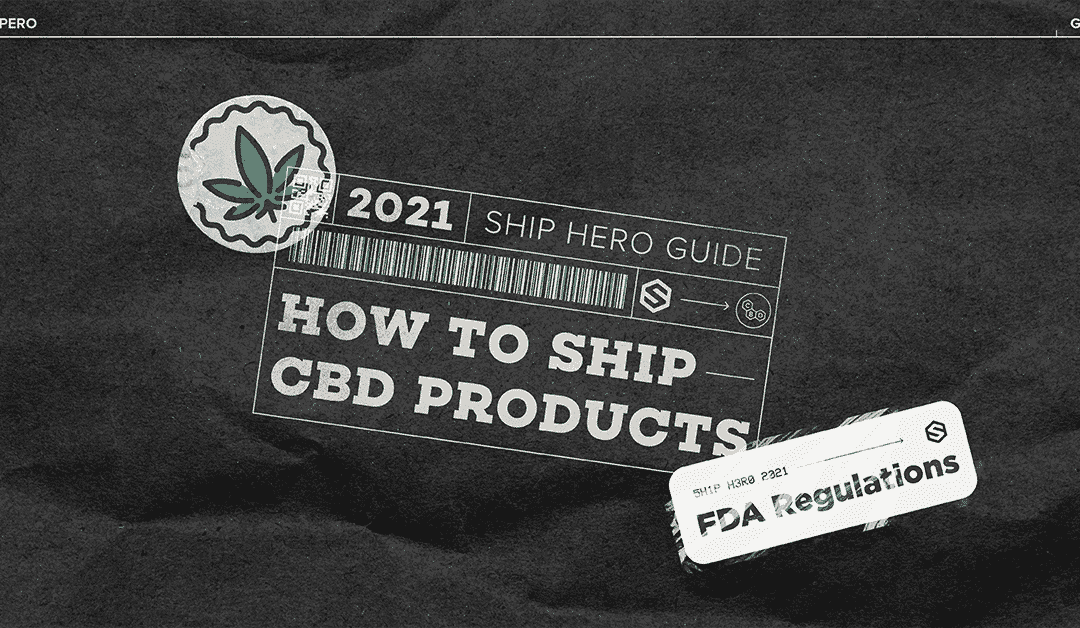
Jun 8, 2021 | 3PL Warehouse Management, Best Practices, Blog, Fulfillment
Relaaaaax! CBD users can get their vapes, tinctures, lotions and more sent right to their doorstep as shipping stress-reducing CBD products have become legal across all 50 states. But suppliers, take heed: supplement and pharmaceutical companies that want their share of this growing $2.8 billion market must comply with the U.S. Government’s CBD shipping regulations, specifically regarding how much THC can be present in their products.
Companies must closely adhere to CBD shipping guidelines if they want to operate long-term. So if you don’t want your CBD business to go up in smoke, be sure to build a detailed strategy for your business, from payment processing to marketing and shipping.
In this article, we get into the nitty-gritty of shipping hemp-based products, including the current state of the market, how to package and ship CBD products and the types of products you can ship out.
Is CBD Legal to Ship? Factors to Keep in Mind
Yes, it’s legal to ship CBD oil and other CBD products, but only under certain circumstances. These are the main factors to keep in mind:
CBD and THC levels
CBD oil is only legal to ship if it is derived from the hemp plant, a type of cannabis plant that contains less THC than marijuana.
Do keep in mind that, according to US federal law, CBD products can only contain up to 0.3% of THC. Any higher and you’re sure to raise red flags.
Selling CBD or other products derived from the marijuana plant is still illegal at the federal level in the US.
If you’re wondering what the differences between hemp, marijuana, CBD and THC are, don’t fret. Here’s a quick explainer:
Marijuana and hemp are essentially the same plants. However, hemp has higher levels of CBD and lower levels of THC, while marijuana has higher levels of THC and lower levels of CBD. THC or tetrahydrocannabinol is the psychoactive agent that is found in cannabis. In short, it’s what gets people high. On the other hand, cannabidiol (CBD) is purported to provide relief for depression, anxiety, and PTSD, as well as help users fall asleep.
Growing licenses
All hemp products containing cannabidiol oil must be bought from a licensed grower. Each state has its own rules and guidelines on issuing licenses to growers, so make sure you or your supplier are able to secure a license from your state before selling any CBD-based products.
Testing
Before you can ship out your CBD products, you must first bring them to a third-party tester to identify the product’s chemical makeup. This will allow you to make any claims on the CBD and THC levels in your product.
The CBD Market in 2022
As CBD sales hit $4.6 billion in 2020, experts forecasted the CBD market to reach $12.64 billion by 2026.
The major growth drivers, according to one report, are rising government approvals of CBD products, increasing cases of chronic pain issues, anxiety, and depression (which CBD is purported to help alleviate), and rising popularity in the cosmetics industry.
One major market trend is the rise in online sales of cannabidiol oil and CBD-containing products. This means more and more people are choosing to have their CBD products delivered straight to their doorsteps rather than going out to buy them at a dispensary.
eCommerce businesses can take advantage of this trend and start catering to those who are reliant on eCommerce to get their CBD products.
The Types of CBD products
Legalized CBD products come in a few different varieties. The market is currently divided by how the supplement is derived from the plant, as well as the method of consumption. For the former, there are three choices available to consumers:
- Hemp
- Marijuana
- Other pharmaceuticals
Hemp-derived CBD products are the most in-demand category for e-commerce retailers, driven by hemp’s various healthcare applications. As medicinal CBD products become more widespread, more research will lead to more uses for it.
As for the method of consumption, CBD can be inhaled like traditional marijuana products, or consumed orally through edibles and other consumables. It can also serve as the main ingredient in health and wellness products, such as skin lotion, shampoo, candles, or animal-care solutions.
Shipping CBD Products Domestically And Internationally
When shipping CBD products locally, keep the following considerations in mind:
Be Careful When Shipping Internationally
Although shipping CBD products is legal in the United States, keep in mind that not all countries classify CBD as a legal substance. Some countries may even press charges or damage products beyond usability. So, not only will you be risking legal action, but you’ll likely see your products go to waste as well.
As such, make sure to check each country’s laws and seek legal advice before conducting business globally. eCommerce retailers need to be mindful of this complex legal landscape and adhere to these laws if they don’t want to lose their business.
Employ a Legal Team
If you’re committed to selling CBD products, make sure to keep a legal team close by to review all your statements and advise you on what you can and can’t do in certain localities. Remember that CBD and hemp-based products are not accepted in all US states despite not being federally-controlled substances.
Screen Your Suppliers
If you will merely be distributing CBD products, you need to be diligent about making sure your suppliers follow state laws and shipping regulations. Most carriers are stringent about having both products and suppliers meet their rules on shipping CBD.
How to Package and Ship CBD
When figuring out how to package your CBD products, it is best to find packaging that is odor-resistant, leak-proof, tamper-resistant, and compliant with state regulations. Vacuum-sealed bags and air-tight plastic containers may be your best bet here. To protect your packages from damage during transport, wrap items in thick, cardboard packaging.
When it comes to shipping, bear in mind that each carrier has different guidelines on shipping hemp-derived CBD products via mail.
USPS Shipping
When shipping through the USPS, you need to meet the following requirements:
- A signed self-certification statement printed on your company’s letterhead stating, “I certify that all information contained in this letter and supporting documents are accurate, truthful, and complete. I understand that anyone who furnishes false or misleading information or omits information relating to this certification may be subject to criminal and/or civil penalties, including fines and imprisonment.”
- Your industrial hemp producer is a licensed producer recognized by the USDA in the state where the post office is located.
- The THC concentration of your product is no higher than 0.3%.
UPS Shipping
To ship via UPS, you must have the following information on hand:
- The state where the industrial hemp was grown
- The manufacturing process that resulted in the end-product
UPS has clear guidelines stating that it will refuse shipment of any marijuana-containing products or CBD products from shops that also sell marijuana products.
DHL
DHL allows shipping of CBD products so long as sellers can provide records on state law compliance, laboratory test results indicating THC contents, government licenses, and compliance reports.
Another solution could be to use third-party logistics or fulfillment providers to handle every aspect of your CBD shipping, from storage to shipping. Fulfillment centers reduce the need to rent warehouses out to store your CBD products and take care of state and federal law compliance when shipping.
How to Market CBD Products
The CBD market is booming, and eCommerce retailers need to stay ahead of the curve. With so many competitors in this industry though there are still plenty of ways you can get your products noticed! Here are some online marketing tactics you can deploy to smoke your competition.
Note: Pay close attention to FDA guidelines on marketing CBD products.
Leverage SEO to Market Your Products
Search Engine Optimization (SEO) is a vital aspect of marketing CBD products. While it can appear complex and technical at first, SEO can still be more affordable and effective than other, more traditional approaches to marketing.
Building informative and entertaining content is the best way to gain traction in the CBD market. Some examples of CBD content marketing could include:
- Outbound posts on social media channels.
- Hashtags to maximize your reach by showing up in more people’s interest feeds.
- Creating a sense of community on social platforms to grow your company’s positive reputation in the industry.
Word-of-mouth and affiliate marketing
Word-of-mouth and affiliate marketing are important tools for eCommerce retailers. Affiliate marketing allows you to build relationships with third-party websites that entice clicks back towards your site, while also paying only when someone buys something because of them!
Influencer Marketing
Somewhat related to affiliate marketing, Influencer marketing is another fruitful channel for spreading product awareness. This is mainly carried out on social media platforms and video. With products such as CBD-related goods, the role of influencers is heavily regulated by the FDA to avoid the unintentional spread of misinformation. The influencer needs to be open and transparent about their commercial connection to the CBD manufacturer and retailer.
Email Marketing
Finally, email marketing still attracts some of the highest conversion rates of all the digital marketing channels. The customers that have subscribed to your updates are quite possibly the easiest pickings for your company to convert sales, so reward your loyal fanbase with discounts, free shipping, and more to generate quick sales.
Wrap It Up
The billion-dollar market for CBD products in the US is still expected to grow 10x its current rate by 2025. For eCommerce retailers that deploy a tight marketing and shipping strategy, the growth opportunities are immense, as long as you follow the FDA guidelines and avoid potentially business-ruining shipping infractions.
Run a tighter ship for your CBD online shop – consider outsourcing your fulfillment to a third-party fulfillment center like ShipHero.
The days of slow shipping are over. ShipHero has a quicker delivery speed than other 3PLs and you’ll be able to spend less money on it, too! Contact us to find out how the pros get their products into satisfied customers’ hands quickly and without breaking your budget or sacrificing quality of service in the process!
Shipping CBD Products FAQs
Can you mail hemp legally?
Yes, you can mail hemp legally as long as its THC concentration does not go any higher than 0.3%.
Can you ship CBD oil internationally?
You can ship CBD oil internationally to countries that recognize CBD as a legal substance. Not all countries do so, however, and may confiscate or destroy your products.
How do I know if my supplier’s CBD can be shipped legally?
To know if your supplier’s CBD is legal to ship, request a license to grow and produce CBD. You can also conduct third-party lab testing to see if their product’s THC levels meet the maximum standard.
–
About ShipHero: We make it simple for you to deliver your eCommerce. Our software helps you run your warehouse, and our outsourced shipping solutions eliminate the hassle of getting your products to your customers. With over 5,000 brands and 3PLs relying on us daily, we’re here to help with all your logistics needs.
Let us know how we can help you today by scheduling a call HERE.



















